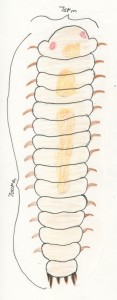By Marissa Scoville
Genus Name: Chaetopterus
Species name: Polychaete worms
Common name: bristle worm

Width 70 micro meter, length 700 micro metersgeneral characteristics
General Characteristics
Polychaete worms are in the kingdom: animalia, phylum: annelida, and class: polychaeta.The word polychaete itself means “many brushes”. This refers to one of the major distingushing characteristics of this marine worm which is polychaete always have elongated, metameric (segmented) bodies with bristles or brushes on some or all of the metameric. Along with these brushes on each of metameric there is also are a pair parapodia (appendages) protruding from each side (Polychaeta Facts & Information Bristle Worms, n.d.). The purpose of these it to help allow the polychaete’s movement, whether crawling, swimming, or burrowing. The head of polychaete worms often have sensory organs or structures for example tentacular palps, antennae and cirri, however not all polychaete’s have this, it depends if they are free-living worms  ( move by crawling, swimming, or burrowing with parapodia) have these sensory organs/structures, sedentary (don’t move, permanent tube-dwellers) who don’t (Polychaeta Facts & Information Bristle Worms, n.d.). Polychaete’s have many different feeding habits (Fauchald, & Jumars, 1979), due to this some have jaws while others don’t (De Kluijve, n.d.). Free-living polychaetes and sedentary polychaetes often have different body types specialized for whichever marine environment they inhabit.
( move by crawling, swimming, or burrowing with parapodia) have these sensory organs/structures, sedentary (don’t move, permanent tube-dwellers) who don’t (Polychaeta Facts & Information Bristle Worms, n.d.). Polychaete’s have many different feeding habits (Fauchald, & Jumars, 1979), due to this some have jaws while others don’t (De Kluijve, n.d.). Free-living polychaetes and sedentary polychaetes often have different body types specialized for whichever marine environment they inhabit.
Marine Environment and Ecology
Polychaetes are mostly marine. They are most commonly found at beaches, inter-tidal zones, high tide zones, islands, sea sediments, waste, watershed, marine biome, ocean (most depths), reefs, and sand. However polychaetes have been found in nearly any temperature or depth (Polychaeta Facts & Information Bristle Worms, n.d.). Bioturbation also know as the breaking down of organic sediment matter is the major role of polychaete worms, especially those located in or near inter-tidal zones (Polychaetes: The Marine Worm, n.d.). In Effects of two polychaete worms, Nereis diversicolor and Arenicola marina, on aerobic and anaerobic decomposition in a sandy marine sediment by Gary T. Banta (et
al) it was found that polychaete worms, specifically Nereis diversicolor and Arenicola marina, have many positive effects on the marine sediments. For
example A. Marina had an sulfate reduction rate of 85% in the same scenario and N. Diversicolor stimulated total benthic metabolism in enriched sediments similarly to sediments enriched with organic matter. Along with bioturbation, polychaete worms are also a vital part of the food chain. Over one hundred organisms prey on polychaete worms such as copepods, nereis and sometimes even other polychaetes. polychaetes aren’t just preyed on by others though, they also prey on over fifty organism such as algae, protozoa and bacteria. The ecological roles polychaete worms play help both their marine environment and the other organisms that they coexist in these environments with.
What Polychaete Worms Represent in the 21st Century to Humans
In the 21st century polychaete worms symbolically represent a dinner plate. The ecological roles polychaete worms play aid the fishing industry because they help provide a healthy environment and a food source. The bioturbation that polychaetes do keeps the organic material from collecting bacteria and using up all the oxygen. Also being a food source to over one hundred organisms polychaetes help to provide food for fish and their larva. Because of there important roles polychaete worms aid the fishing industry that provides food for humans, thus symbolically represent a dinner plate to humans in the 21st century.

Citations
Introduction to the Polychaeta. (n.d.). Retrieved November 18, 2015, from http://www.ucmp.berkeley.edu/annelida/polyintro.html
Polychaeta Facts & Information Bristle Worms. (n.d.). Retrieved November 18, 2015, from http://eol.org/pages/84/data
Australian Museum. (2015, October 26). Retrieved November 18, 2015, from http://australianmuseum.net.au/segmented-worms-the-polychaetes
Fauchald, K., & Jumars, P. (1979). The Diet of Worms: A Study of Polychaete Feeding Guilds. Retrieved November 18, 2015, from http://www.researchgate.net/profile/Peter_Jumars/publication/255608624_Diet_of_worms_a_study_of_polychaete_feeding_guilds/links/02e7e5371f8f32da
De Kluijve, M. (n.d.). Marine Species Identification Portal : Abyssoninoe hibernica. Retrieved November 18, 2015, from http://species-identification.org/species.php?species_group=macrobenthos_polychaeta&menuentry=inleiding&id=3&tab=foto
“Polychaetes: The Marine Worm” (n.d.). Retrieved November 18, 2015, from http://lkcnhm.nus.edu.sg/polychaete/Introworms.html
Woodin, S. (1974). Polychaete Abundance Patterns in a Marine Soft-Sediment Environment: The Importance of Biological Interactions. Retrieved November 18, 2015, from http://www.jstor.org/stable/pdf/1942310.pdf?acceptTC=true
Gary T. Banta,Marianne Holmer, Mikael H. Jensen,Erik Kristensen (1999, October 1) Effects of two polychaete worms, Nereis diversicolor and Arenicola marina, on aerobic and anaerobic decomposition in a sandy marine sediment. Retrieved November 18, 2015, from http://www.researchgate.net/profile/Erik_Kristensen/publication/236628293_Effects_of_two_polychaete_worms_Nereis_diversicolor_and_Arenicola_marin
Chesapeake Bay Life Benthos Polychaetes. (n.d.). Retrieved November 18, 2015, from http://www.dnr.state.md.us/bay/cblife/benthos/polychaetes.html
copyright 2015 Marissa Scoville



1 Pingback